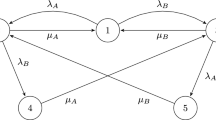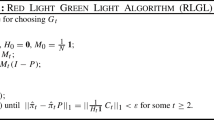Abstract
In this paper we reason about the notion of proportional lumpability, that generalizes the original definition of lumpability to cope with the state space explosion problem inherent to the computation of the performance indices of large stochastic models. Lumpability is based on a state aggregation technique and applies to Markov chains exhibiting some structural regularity.
Proportional lumpability formalizes the idea that the transition rates of a Markov chain can be altered by some factors in such a way that the new resulting Markov chain is lumpable. It allows one to derive exact performance indices for the original process.
We prove that the problem of computing the coarsest proportional lumpability which refines a given initial partition is well-defined, i.e., it has always a unique solution. Moreover, we introduce a polynomial time algorithm for solving the problem. This provides us further insights on both the notion of proportional lumpability and on generalizations of partition refinement techniques.
Access this chapter
Tax calculation will be finalised at checkout
Purchases are for personal use only
Similar content being viewed by others
References
Alzetta, G., Marin, A., Piazza, C., Rossi, S.: Lumping-based equivalences in Markovian automata: algorithms and applications to product-form analyses. Inf. Comput. 260, 99–125 (2018). https://doi.org/10.1016/j.ic.2018.04.002
Baarir, S., Beccuti, M., Dutheillet, C., Franceschinis, G., Haddad, S.: Lumping partially symmetrical stochastic models. Perform. Eval. 68(1), 21–44 (2011). https://doi.org/10.1016/j.peva.2010.09.002
Balsamo, S., Marin, A.: Queueing networks. In: Bernardo, M., Hillston, J. (eds.) SFM 2007. LNCS, vol. 4486, pp. 34–82. Springer, Heidelberg (2007). https://doi.org/10.1007/978-3-540-72522-0_2
Buchholz, P.: Exact and ordinary lumpability in finite Markov chains. J. Appl. Probab. 31, 59–75 (1994). https://doi.org/10.1017/S0021900200107338
Courtois, P.J., Semal, P.: Computable bounds for conditional steady-state probabilities in large Markov chains and queueing models. IEEE J. Sel. Areas Commun. 4(6), 926–937 (1986)
Derisavi, S., Hermanns, H., Sanders, W.H.: Optimal state-space lumping in Markov chains. Elsevier Inf. Process. Lett. 87(6), 309–315 (2003)
Franceschinis, G., Muntz, R.: Bounds for quasi-lumpable Markov chains. Perform. Eval. 20(1–3), 223–243 (1994). https://doi.org/10.1016/0166-5316(94)90015-9
Franceschinis, G., Muntz, R.: Computing bounds for the performance indices of quasi-lumpable stochastic well-formed nets. IEEE Trans. Software Eng. 20(7), 516–525 (1994). https://doi.org/10.1109/32.297940
Frostig, E.: Jointly optimal allocation of a repairman and optimal control of service rate for machine repairman problem. Eur. J. Oper. Res. 116(2), 274–280 (1999)
Hermanns, H.: Interactive Markov Chains. LNCS, vol. 2428. Springer, Heidelberg (2002). https://doi.org/10.1007/3-540-45804-2
Hillston, J.: A Compositional Approach to Performance Modelling. Cambridge Press (1996). https://doi.org/10.1017/CBO9780511569951
Hooghiemstra, G., Koole, G.: On the convergence of the power series algorithm. Perform. Eval. 42(1), 21–39 (2000)
Katehakis, M., Derman, C.: Optimal repair allocation in a series system. Math. Oper. Res. 9(4), 615–623 (1984)
Katehakis, M., Smit, L.: A successive lumping procedure for a class of Markov chains. Probab. Eng. Inf. Sci. 26(4), 483–508 (2012)
Kemeny, J.G., Snell, J.L.: Finite Markov Chains. Springer, New York (1976)
Kuo, J., Wei, J.: Lumping analysis in monomolecular reaction systems. Analysis of approximately Lumpable system. Ind. Eng. Chem. Fundam. 8(1), 124–133 (1969)
Ledoux, J.: A necessary condition for weak lumpability in finite Markov processes. Oper. Res. Lett. 13(3), 165–168 (1993)
Li, G., Rabitz, H.: A general analysis of exact lumping in chemical kinetics. Chem. Eng. Sci. 44(6), 1413–1430 (1989)
Marin, A., Piazza, C., Rossi, S.: Proportional Lumpability. In: André, É., Stoelinga, M. (eds.) FORMATS 2019. LNCS, vol. 11750, pp. 265–281. Springer, Cham (2019). https://doi.org/10.1007/978-3-030-29662-9_16
Marin, A., Piazza, C., Rossi, S.: Proportional lumpability and proportional bisimilarity. Acta Informatica (2021). https://doi.org/10.1007/s00236-021-00404-y
Marin, A., Rossi, S.: On the relations between Markov chain lumpability and reversibility. Acta Informatica 54(5), 447–485 (2017). https://doi.org/10.1007/s00236-016-0266-1
Molloy, M.K.: Performance analysis using stochastic petri nets. IEEE Trans. Comput. 31(9), 913–917 (1982). https://doi.org/10.1109/TC.1982.1676110
Paige, R., Tarjan, R.E.: Three partition refinement algorithms. SIAM J. Comput. 16(6), 973–989 (1987)
Plateau, B.: On the stochastic structure of parallelism and synchronization models for distributed algorithms. SIGMETRICS Perf. Eval. Rev. 13(2), 147–154 (1985). https://doi.org/10.1145/317795.317819
Schweitzer, P.: Aggregation methods for large Markov chains. In: Proceedings of the International Workshop on Computer Performance and Reliability, pp. 275–286. North Holland (1984)
Sumita, U., Rieders, M.: Lumpability and time-reversibility in the aggregation-disaggregation method for large Markov chains. Commun. Stat. Stoch. Models 5, 63–81 (1989). https://doi.org/10.1080/15326348908807099
Ungureanu, V., Melamed, B., Katehakis, M., Bradford, P.: Deferred assignment scheduling in cluster-based servers. Clust. Comput. 9(1), 57–65 (2006)
Valmari, A., Franceschinis, G.: Simple O(m logn) time Markov chain lumping. In: Esparza, J., Majumdar, R. (eds.) TACAS 2010. LNCS, vol. 6015, pp. 38–52. Springer, Heidelberg (2010). https://doi.org/10.1007/978-3-642-12002-2_4
Author information
Authors and Affiliations
Corresponding author
Editor information
Editors and Affiliations
A Appendix
A Appendix
1.1 Proof of Lemma 1
First notice that each block \(A\in \mathcal P\) can be written both as a union of blocks of \(\mathcal P_1\) and as a union of blocks of \(\mathcal P_2\), i.e.,
with \(A_{ij}\in \mathcal P_i\).
Since \(\mathcal P_1\) and \(\mathcal P_2\) are proportional partitions, there exist two functions \(\kappa _1,\kappa _2\) from \(\mathcal S\) to \(\mathbb R^+\) that witness this fact. This implies that if we take two states s and \(s'\) which are not in A and are in a block \(B_i\) of \(\mathcal P_i\), it holds that:
This last can be rewritten as:
For each block \(B\in \mathcal P\) we fix a representative element \(b\in B\). For each \(b'\in B\) there exists at least one finite sequence \(b_0,b_1,\dots ,b_m\) such that \(b_0=b\), \(b_m=b'\) and for each \(h=0,\dots ,m-1\) there exists \(B_{h}\) such that \(b_h,b_{h+1}\in B_h\) and either \(B_{h}\in \mathcal P_1\) or \(B_h\in \mathcal P_2\). For each \(b'\in B\) we fix one of such sequences. For the sake of clarity, let us consider a simple case where \(b,b_1\in B_0 \in \mathcal P_1\), \(b_1,b_2\in B_1 \in \mathcal P_2\), and \(b_2,b'\in B_2\in \mathcal P_1\). Let \(A\in \mathcal P\) with \(A\ne B\). In virtue of the last equation, we have:
In the general case we obtain:
where \(K(b,b')\) is a product of fractions involving values of \(\kappa _1\) and \(\kappa _2\) that depends on the sequence that we have fixed from b to \(b'\). Since both b and the sequence have been fixed we can define \(\overline{K}(b')=K(b,b')\). As a consequence, if \(b', b''\in B\) we obtain that for each \(A\in \mathcal P\) with \(A\ne B\) it holds
This means that \(\mathcal P\) is a proportional partition. \(\square \)
1.2 Proof of Lemma 4
Let \(S_j=A_1\cup \dots \cup A_n\) and \(S_k=B_1\cup \dots B_m\) with \(A_f,B_h\in \mathcal P_{\sim }\). Let \(\kappa \) be a function witnessing that \(\mathcal P_{\sim }\) is a proportional lumpability. If by contradiction there exists a block \(C\in \mathcal P_{\sim }\) such that \(s,s'\in C\), then we would have
for each \(f=1,\dots , n\) and
for each \(h=1,\dots , m\). As a consequence by summing for \(f= 1,\dots , n\) and \(h=1,\dots , m\) we have
Since by hypothesis it holds \(q(s,S_k)\ne 0\) and \(q(s',S_k)\ne 0\) we get
which contradicts the hypothesis. \(\square \)
1.3 Proof of Theorem 5
The existence of at least one solution is trivial, since the identity relation is a proportional lumpability.
As far as the uniqueness is concerned, let us consider the maximum proportional partition problem over X(t) and \(\mathcal P\). Let us assume by contradiction that the set of proportional partitions that refines \(\mathcal P\) has at least two different maximal elements. This means that there are two different partitions \(\mathcal Q_1\) and \(\mathcal Q_2\) such that:
-
a.
\(\mathcal Q_i\) is a proportional partition;
-
b.
\(\mathcal Q_i\) refines \(\mathcal P\);
-
c.
each \(\mathcal Q'\) coarser than \(\mathcal Q_i\) and refining \(\mathcal P\) is not a proportional partition.
By Lemma 1 the smallest partition \(\mathcal Q\) that is coarser than both \(\mathcal Q_1\) and \(\mathcal Q_2\) is a proportional partition. Moreover, since both \(\mathcal Q_1\) and \(\mathcal Q_2\) refine \(\mathcal P\), it holds that \(\mathcal Q\) refines \(\mathcal P\). This contradicts item c. \(\square \)
Rights and permissions
Copyright information
© 2021 Springer Nature Switzerland AG
About this paper
Cite this paper
Piazza, C., Rossi, S. (2021). Reasoning About Proportional Lumpability. In: Abate, A., Marin, A. (eds) Quantitative Evaluation of Systems. QEST 2021. Lecture Notes in Computer Science(), vol 12846. Springer, Cham. https://doi.org/10.1007/978-3-030-85172-9_20
Download citation
DOI: https://doi.org/10.1007/978-3-030-85172-9_20
Published:
Publisher Name: Springer, Cham
Print ISBN: 978-3-030-85171-2
Online ISBN: 978-3-030-85172-9
eBook Packages: Computer ScienceComputer Science (R0)




